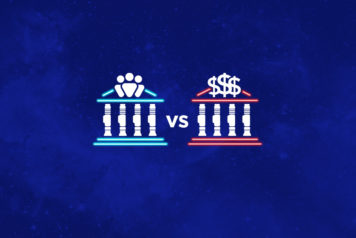Get to the Next Level with a Certificate Ladder
If you’re making a plan to grow your savings, share certificates (aka “savings certificates” or “certificates”) are a great option. They allow you to earn a good return on your money while keeping it accessible enough to use for major expenses. If you’re planning on buying a house or a car, keeping your down payment money in a certificate can help it grow toward your goal a little faster.
What if, though, you’re saving for more than one thing at a time? It’s difficult to make partial withdrawals from a certificate, and doing so can hurt your earnings. Let’s take a look at three ways to make your savings grow while remaining flexible enough to use when you need it.
Lump it all together
One option would be to put all your savings goals into one certificate. You’d take your house down payment, your car funds, your vacation savings, and your rainy day money and put them all in a single certificate. This strategy is simple and straightforward.
The Good
First, there’s only one statement to keep track
of each month. At tax time, you’ll only have one document that shows the
dividends you’ve earned, and you won’t have to track down multiple pieces of
paper to figure out how much you’ve got saved. You can make withdrawals when it
comes time to achieve your savings goals, and put the remainder into a
new certificate at
that time. Sometimes, larger sums of money earn better rates, so lumping all
your money together can improve your return over the long haul.
The Bad
Because all the money is in one pot, it can be
difficult to determine how close you are to each goal. You’re also stuck on the
time frame of your shortest-term goal. If you want to buy a car in a year from
now, you can only get a one-year term to save for everything, including the
house you want to put a down payment on in five years. That short-term rate may
not be as good as you could get otherwise.
The Bottom Line
If all your savings goals are on a similar time
frame, or if simplifying your financial life is your foremost priority, a
single certificate for
all your savings is a good idea.
Different Certificates for Different Goals
In this slightly more complicated approach, you
would open one certificate for
your car down payment, one for your house savings and one for your emergency
fund. These would all be held in different certificate accounts, and would earn interest
separately.
The Good
Since each of your savings goals are in
individual accounts, you can get better rates by locking long-term goals into
long-term certificates. Instead of keeping all your money tied to the term of
your shortest goal, you can stagger your terms to meet the individual needs of
all your goals. This will allow you to lock in better rates and make more
strategic withdrawals at the time you need the money. Dividend rates change
over time, so multiple certificates allow you to avoid the risk of missing
better rates, since you have more opportunities to re-lock rates.
The Bad
The variable interest rates can make figuring
your earnings difficult, and the multiple accounts can create some confusion
when tax filing time arrives. Having multiple accounts also might keep you from
getting the best dividend rates, which are reserved for larger balances.
So-called “jumbo” certificates can magnify returns if your savings exceeds a
certain amount. You may also have an emergency that requires you to dip into
savings; in these instances, you may have difficulty accessing a significant
portion of your money.
The Bottom Line
Multiple certificate accounts offer a combination of
flexibility and security that would be helpful for those with a diverse range
of goals.
The Ladder
A certificate “ladder” is a strategy that uses multiple long-term
certificates opened at regular intervals. The objective of a ladder is to secure the best rates possible while
ensuring some money is still available at regular intervals. For example, a
five-year ladder involves buying a
series of certificates so a five-year account is maturing each year.
The Good
A ladder is very flexible and it helps to lock in
the best available rates. Long-term certificates have the best rates,
regardless of size, and a certificate ladder lets you take advantage of them. It also
protects you against the usual problem of long-term certificates. When rates
change, you have the flexibility to reinvest and secure those rates.
The Bad
Setting up a certificate ladder can require some very careful planning,
and the minimum investment is much higher. Instead of needing the minimum
deposit for one certificate,
you need the minimum deposit for five of them. Additionally, only one-fifth of
your savings are available at any one time. If you’re saving for a large single
goal, this can complicate matters considerably.
The Bottom Line
Ladders are a complex strategy that can maximize
returns for those who are saving for flexible goals like vacations, home
renovations and vehicles.
Whatever your financial plan, certificates have an important role to play. They make it easier to save for your short-term and long-term goals, plus once you’ve got your ladder set up, you can set it to auto-renew. The ultimate “set it and forget it” strategy to save, grow, and be prepared for whatever life might throw your way.
This article is for educational purposes only. WeStreet Credit Union makes no representations as to the accuracy, completeness, or specific suitability of any information presented. Information provided should not be relied on or interpreted as legal, tax or financial advice. Nor does the information directly relate to our products and/or services terms and conditions.


